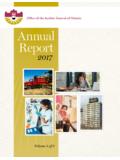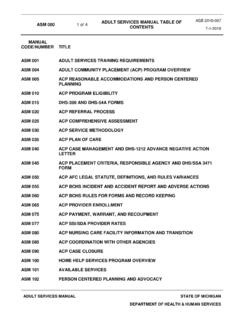Transcription of 3.09: Long-term-care Home Quality Inspection …
1 Chapter 3 Ministry of Health and Long-Term care Section Long-term-care home Quality Inspection Program homes; and funding and licensing of homes. The Background Act provides the Ministry with the power to ensure homes are in compliance with the legislation and to take enforcement actions, if necessary. By law, Overview of Long-term-care every Long-term-care home must have a residents'. Homes Chapter 3 VFM Section council (made up of people who live in the home ). Ontario's Long-term-care homes provide accom- A home may also have a family council (made up modation and care in a home -like environment to of family members of current or past residents). adults who are unable to live independently and/or The purpose of these councils is to provide a voice require round-the-clock nursing care in a secure set- for residents and their family members on how the ting. There are about 630 Long-term-care homes in home is operated.
2 Ontario. They provide care to approximately 77,600 The Canadian Institute for Health Information residents, most of whom are over 65 years old. (CIHI) reports regularly on a number of Quality The Ministry of Health and Long-Term care indicators based on the information self-reported (Ministry) funds, licenses and regulates Ontario's by Long-term-care homes in Ontario. In 2015, CIHI. Long-term-care homes. Homes can be either for- published nine Quality indicators on homes, such profit or not-for-profit, which are further categor- as the percentage of residents who are in daily ized as municipal and non-municipal homes, as restraints, the percentage of residents who are shown in Figure 1. In the 2014/15 fiscal year, ministry funding to Long-term-care homes through Figure 1: Long-term-care Homes in Ontario, the province's Local Health Integration Networks March 2015. totalled $ billion. Most residents make a co- Source of data: Ministry of Health and Long-Term care payment of between $1,800 and $2,500 a month, Type of Long-term-care home # of Homes # of Beds depending on whether they occupy a basic, semi- For-profit homes 360 41,800.
3 Private or private room. Not-for-profit homes 170 20,300. The Long-Term care Homes Act, 2007 (Act) came (other than municipal homes). into effect on July 1, 2010. The Act and its regula- Not-for-profit homes 100 16,400. tions set out standards for all Long-term-care homes (municipal homes). in Ontario. The Act covers residents' rights, care Total 630 78,500*. and services; admission of residents; operation of * Of which, approximately 77,600 beds were occupied as of March 2015. 363. 364 2015 Annual Report of the Office of the Auditor General of Ontario taking antipsychotic drugs without a diagnosis of having to alert the homes beforehand. There are psychosis, the percentage of residents who fell in four types of inspections: comprehensive inspec- the last 30 days and the percentage of residents tions, complaint inspections, critical-incident with a worsened pressure ulcer. Appendix 1 shows inspections and follow-up inspections.
4 Figure 2. the results for the nine Quality indicators by region shows the number for each type of Inspection for 2013/14 (2013/14 is the most recent year for conducted between 2012 and 2014. During 2014, which data from individual homes is available), as the Ministry performed a total of 2,630 inspections, well as the change in overall provincial perform- 210 more than the number performed in 2013. The ance between 2010/11 and 2013/14. Overall, increase is mainly due to additional comprehensive results for four of the nine indicators improved by inspections that year. The process for each type of between 6% and 45% over these three years, while Inspection is described in the following subsections. the results for the other five indicators worsened by between 2% and 7% over the same three years. Comprehensive Inspections In early 2011, the Ministry implemented compre- The Ministry's Long-Term hensive inspections, which aim to assess residents'.
5 care Homes Quality Inspection satisfaction and homes' compliance with legislative Program requirements. To increase Inspection efficiency and avoid duplication, the Ministry can inspect com- Program Overview plaints, critical incidents and/or follow up on com- Chapter 3 VFM Section The aim of the Long-Term care Homes Quality pliance orders during a comprehensive Inspection . Inspection Program (Program) is to focus on resi- On average, a comprehensive Inspection involves dents' Quality of care and Quality of life by protecting three or four inspectors examining the home over and safeguarding residents' rights, safety and secur- an eight-day period. This Inspection process has ity as well as ensuring that Long-term-care homes two stages and 31 Inspection protocols, five of comply with legislation and regulations. A similar which are mandatory protocols (medication; infec- program existed before but was transformed to tion prevention and control; residents' council and align with the Act when it came into effect in 2010.)
6 Family council interviews; and dining observation). The Program is administered by the Ministry's In the first stage of a comprehensive Inspection , Performance Improvement and Compliance Branch, inspectors review health records, make observations which falls under its Health System Accountability and Performance Division. The Program consists of Figure 2: Number of Inspections by Type, 2012 20141. a head office with a centralized intake unit and five Source of data: Ministry of Health and Long-Term care regional offices. In total, the Program has about 200 Type of Inspection 2012 2013 2014. staff, including over 150 inspectors. Each regional Comprehensive 2 60 50 590. office has a manager and two inspector team leads Critical-incident3 700 940 810. who prioritize and assign inspections to inspectors Complaint3 1,190 1,140 970. and oversee their work. Appendix 2 summarizes Follow-up 4 290 290 260.
7 The key roles, responsibilities and accountability Total 2,240 2,420 2,630. relationships in Long-term-care home oversight. 1. Based on calendar year. Data prior to 2012 is either incomplete or not available. 2. When conducting comprehensive inspections, Ministry inspectors may Types of Inspections also address critical incidents or complaints, or follow up on orders issued. 3. The Ministry addressed approximately 2,970, 2,540 and 3,840. complaints and critical incidents in 2012, 2013 and 2014, respectively. Under the Act, the Ministry may conduct inspec- 4. The Ministry followed up on approximately 510, 610 and 770. tions of Long-term-care homes at any time without compliance orders in 2012, 2013 and 2014, respectively. Compliance orders can also be followed up during any types of Inspection . Long-term-care home Quality Inspection Program 365. in the homes, and interview a sample of residents, Inspection protocol(s) (see Appendix 3) that best their family members and/or staff members who match the nature of the complaint.
8 The Ministry care for them. Inspectors analyze the information has an internal policy that requires inspectors to collected and identify areas for further, more in- report the outcome of a complaint Inspection to the depth Inspection in stage two. complainant(s). See Appendix 3 for a more detailed overview of the comprehensive Inspection process and inspec- Critical-incident Inspections tion protocols. Long-term-care homes must immediately report critical incidents to the Ministry, such as: fire, Complaint Inspections neglect or abuse of residents, improper care , misuse The Ministry receives complaints from residents, of residents' money, unlawful conduct, unexpected their family members, and the public mostly by or sudden death, residents missing for more than phone (through a toll-free ServiceOntario Action three hours, missing residents who return with an Line) but also in person and by email or fax.
9 Injury or adverse change in condition, outbreaks Long-term-care homes are also required to immedi- of reportable or communicable diseases, and ately forward any written complaints they receive contamination of the drinking water supply. For to the Ministry. other incidents, such as resident falls resulting in Since November 2012, the Ministry's central- significant change in condition that require a hos- ized intake unit has responsibility for reviewing pital visit, failures of the home 's security or other Chapter 3 VFM Section every complaint it receives and to decide whether major systems for more than six hours, and missing an Inspection is warranted ( , any indications medication, the homes are required to inform the of a home failing to comply with the legislation). Ministry within one business day. Homes report In 2014, the Ministry received close to 3,300 critical incidents through a web-based tool called complaints (2013 2,910).
10 If it decides that an the Critical Incident System or through a pager if Inspection is required, the unit assigns a risk level the incident occurs after business hours. In 2014, to each case: high, medium or low. High-risk cases the long-term-homes reported over 12,900 critical involve alleged improper care , abuse, neglect, incidents (2013 15,300) to the Ministry. unlawful conduct, or retaliation by the homes' The Ministry's centralized intake unit reviews staff anything that places resident(s) in serious every critical incident reported to decide whether (or significant risk of serious) harm and in immedi- an Inspection is warranted. The Inspection process ate jeopardy if the Ministry or the home fails to to address a critical incident is the same as the intervene. Medium-risk cases involve any alleged process for complaint inspections described in the violation of the Act that result in moderate (or risk previous section.)











